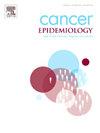The incidence trends of papillary thyroid carcinoma in Belarus during the post-Chernobyl epoch
IF 2.4
3区 医学
Q3 ONCOLOGY
引用次数: 0
Abstract
Background
The increase of papillary thyroid cancer (PTC) rate among children who were exposed to post-Chernobyl 131-I release was reported only four years after the accident, first in Belarus where the heaviest fallout happened. The evolution of the occurrence of thyroid carcinoma based on the age-period-cohort analysis and the effects of age, period, and birth cohort on time trends aimed to reveal if post-Chernobyl follicular cells irradiation still has been impacting on incidence rate of papillary thyroid carcinoma nowadays.
Methods
The Belarusian Cancer Registry was used to identify patients with PTC diagnosed during the years 1980–2019. The incidence trends were analysed using Join-point regression software.
Results
The highest peak of age-specific incidence curve was shown during the years 1980–2001 in the age group of 15–19 years old that was associated also with short-latency cases of post-Chernobyl PTC. This is the same age group that demonstrated significant growth of the incidence rate during the years 2006–2019, largely because of the increasing number of non-exposed patients with PTC (p < 0.001). Influence of post-Chernobyl exposure also can be seen in the young adults age-groups of patients (for 20–24 years old during the years 1980–2003 and 2013–2019, p < 0.001; for 25–29 years old during the years 1980–1999 and 1999–2011, p < 0.001).
Conclusion
After the Chernobyl accident, epidemiological waves that reflect the age shift of the group of children exposed to 131-I have consistently emerged. Currently, the incidence rate continues to increase only in the cohort of patients aged 20–44 years.
后切尔诺贝利时代白俄罗斯甲状腺乳头状癌的发病率趋势。
背景:切尔诺贝利核电站事故后131-I释放物导致儿童甲状腺乳头状癌(PTC)发病率上升的报道仅出现在事故发生四年后,首先出现在核辐射最严重的白俄罗斯。根据年龄-时期-队列分析以及年龄、时期和出生队列对时间趋势的影响,研究了甲状腺癌发病率的演变,旨在揭示切尔诺贝利事故后的滤泡细胞辐照是否仍在影响当今甲状腺乳头状癌的发病率:方法:利用白俄罗斯癌症登记处对1980-2019年间确诊的甲状腺乳头状癌患者进行识别。使用Join-point回归软件分析了发病趋势:结果:1980-2001 年期间,15-19 岁年龄组的年龄特异性发病率曲线达到最高峰,这也与切尔诺贝利事故后 PTC 的短时病例有关。2006 年至 2019 年期间,这一年龄组的发病率也出现了显著增长,这主要是因为非暴露于切尔诺贝利核电站事故的 PTC 患者人数不断增加(p 结论):切尔诺贝利事故发生后,反映暴露于 131-I 的儿童群体年龄变化的流行病学浪潮不断涌现。目前,只有 20-44 岁年龄组的患者发病率持续上升。
本文章由计算机程序翻译,如有差异,请以英文原文为准。
求助全文
约1分钟内获得全文
求助全文
来源期刊

Cancer Epidemiology
医学-肿瘤学
CiteScore
4.50
自引率
3.80%
发文量
200
审稿时长
39 days
期刊介绍:
Cancer Epidemiology is dedicated to increasing understanding about cancer causes, prevention and control. The scope of the journal embraces all aspects of cancer epidemiology including:
• Descriptive epidemiology
• Studies of risk factors for disease initiation, development and prognosis
• Screening and early detection
• Prevention and control
• Methodological issues
The journal publishes original research articles (full length and short reports), systematic reviews and meta-analyses, editorials, commentaries and letters to the editor commenting on previously published research.
 求助内容:
求助内容: 应助结果提醒方式:
应助结果提醒方式:


